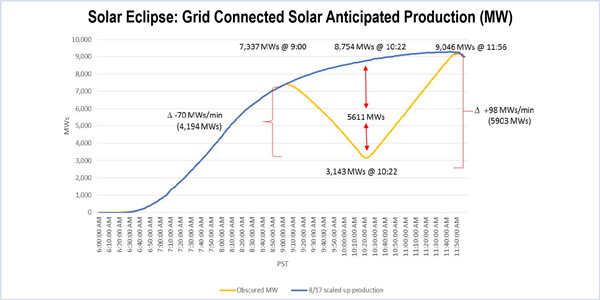By Robert Mullin
For nearly three hours this summer, a solar eclipse will blackout much of California’s growing volume of solar generating resources, forcing the state’s grid operator to cover the shortfall with a bevy of resources equipped to quickly react to dispatch instructions.
CAISO is already well into developing its response to the Aug. 21 event.
On that date, the California sun will be reach its dimmest point at 10:22 a.m., the eclipse’s moment of maximum “obscuration.” By that time, CAISO’s “net load” — the portion of electricity demand not served by renewable resources — will have surged to about 6,000 MW more than what it would normally be on a sunny summer day.
The primary reason: The temporary loss of 5,600 MW of energy from grid-connected solar that would typically be generating at that time under full-sun conditions.
An accompanying drop-off in output from behind-the-meter solar will add to the impact, bumping up net load by about 8%.
Solar declines are forecast to be uneven throughout the state, with obscuration rates ranging from 76% in the northern San Joaquin Valley to 58% near the border with Mexico.
“We’re going to start losing solar during the morning ramp,” Amber Motley, CAISO manager of short-term forecasting, said during a May 1 meeting of CAISO’s Board of Governors, where she described the ISO’s ongoing preparations. (See CAISO Planners Looking Ahead to Summer 2017 Solar Eclipse.)
Motley called the timing of the eclipse “a little bit of a blessing” compared with the situation faced by European system operators in 2015, when a similar event there coincided with the sharper evening ramp.
Still, the ISO expects to lose about 70 MW of solar output per minute from the start of this summer’s eclipse to its fullest point, accelerating the morning ramp to two to three times its normal rate.
Mark Rothleder, CAISO vice president for market quality and renewable integration, pointed to another notable detail: Aug. 21 falls on a Monday.
“It’s not unusual on a Monday during summer, especially if you have several hot days leading up to that Monday, that you could have a high load and potentially a peak condition for the year,” Rothleder said.
But Motley counted other blessings, including the fact that populous areas of California are subject to “marine layers” — low-altitude cloud cover — during August mornings.
And then there’s heavy snowpack that is feeding the state’s hydroelectric system to the point of oversupply this spring. (See Spring Oversupply Lifts CAISO Curtailments.)
“We know we have a lot of hydropower this year. It’s a blessing,” Motley said, referring to the ramping capability of those resources. “That’s something we expect will still be available in August.”
To help manage the ramp, CAISO will increase its coordination with hydroelectric producers to ensure that they’re prepared to bid into the wholesale market that day. The ISO also plans to increase regulation reserves by about one-third — 350 to 400 MW, a number that staff will revisit after performing market simulations. Those simulations will also provide insight into whether the ISO needs to make any adjustments to how its flexible ramp product performs during the eclipse period.
CAISO will also “coordinate very heavily” with natural gas suppliers to ensure that gas-fired generators procure an adequate supply of fuel.
Another potential option: the manual curtailment of renewables ahead of the eclipse.
“I think that the market simulation will really show us how the market can handle this particular set of movements throughout the day, but [curtailment] was something that was utilized in Europe,” Motley said.
With solar output expected to increase at a rate of 90 MW/minute coming out the eclipse, the ISO is considering placing a constraint on that upward ramp, which will necessitate a corresponding downward ramp for dispatchable resources.
“That 90-MW return is quite steep,” Motely said.
The ISO will depend on the Western Energy Imbalance Market (EIM) for additional measures. With other EIM areas experiencing the eclipse at different times, the market’s software “will be able to optimize EIM transfer capability and use that as a feature as we go through the eclipse,” Motley said.
Grid-connected solar output will decline by 866 MW in other EIM balancing areas during the eclipse. Nearly all the reductions will be concentrated in Arizona and Nevada.
CAISO staff plan to present stakeholders with their preparations for the eclipse during a Market Performance and Planning Forum on July 18 — about one month before the event.
“We look forward to being informed about this,” said ISO board member Angelina Galiteva. “This is interesting — and it’s going to be a test case for what’s to come in the future on a much more regular basis.”





